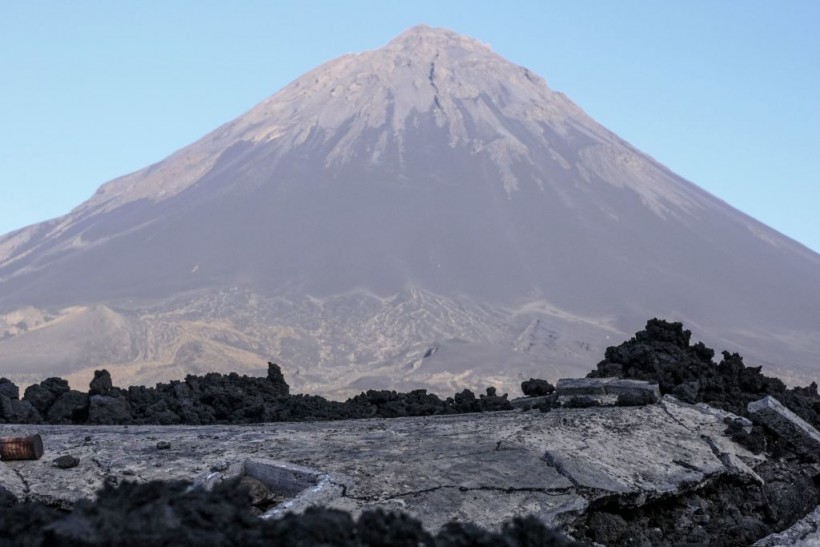The National Academy of Sciences' recent study, titled "Oceanic Intraplate Explosive Eruptions Fed Directly From the Mantle" published in the journal PNAS, challenges established ideas about volcanic eruptions.
Traditional beliefs pointed to water and shallow crustal magma as primary triggers, but the study presents a new contender: gaseous carbon dioxide. The research enhances comprehension of Earth's internal processes, influencing enhanced approaches to volcanic hazard readiness.

This picture taken on March 31, 2019, shows the volcano Pico do Fogo and the remains of the roof of a house submerged by lava during the last eruption in 2014, in the village of Portelo in Cape Verde's Cha das Caldeiras valley.
Carbon Dioxide Desimeter Offers Insight Into the Volcano's Magma History
According to the novel concept, basaltic volcanoes, typically situated within tectonic plates, draw sustenance from magma originating around 20 to 30 kilometers below the Earth's exterior.
Esteban Gazel, a senior researcher from Cornell University, said in the press release that this fundamentally shifts paradigm of how eruption mechanisms operate. While water was previously the focal point in volcanic models, the new model shows that it plays a minor role in these volcanoes. Instead, it is carbon dioxide that propels magma from the Earth's depths.
Gazel, in collaboration with Charlotte DeVitre from the University of California, Berkeley, took the lead in developing an advanced densimeter specialized for carbon dioxide. As per Interesting Engineering, this groundbreaking device effectively measures density within a tiny container, uniquely tailored for Raman spectroscopy, which investigates the scattering of photons using a microscope.
More so, this novel approach enabled them to investigate minute carbon dioxide-rich bubbles preserved in volcanic crystals, providing valuable insights into the history of magma.
The researchers also introduced methodologies to analyze the influence of laser heating on inclusions abundant in carbon dioxide within crystals. They accurately evaluated the volumes of both molten inclusions and bubbles, even formulating an experimental reheating technique to enhance accuracy and address instances of carbon dioxide being trapped as carbonate crystals within the bubbles.
New Discovery Could Help Improve Planning for Future Volcanic Eruptions
According to Live Science, the discovery concerns basaltic volcanoes situated within tectonic plates, not at their edges. Unlike other types, these volcanoes eject low-viscosity lava, which flows more easily and swiftly. Their eruptions can be highly explosive, particularly if relatively cool lava rapidly reaches the surface, causing the formation of crystals that are propelled across the terrain.
Despite constituting over half of the world's volcanoes, basaltic ones have received less research attention compared to those producing thicker lava, as highlighted by the recent study.
Basaltic volcanoes, including Kīlauea and Mauna Loa in Hawaii, as well as Pico do Fogo in the Cabo Verde archipelago, exemplify this type. Pico do Fogo, notably active, has experienced around 30 eruptions since the 15th century, with the latest eruption ending in 2015, spreading fluid lava over more than 1.5 square miles of land and two villages.
Researchers noted that the study's findings could enhance eruption hazard management. Gazel highlighted the importance of pinpointing eruption origins and magma storage locations.
Through accurate measurements that reveal eruption origins, magma melting points, storage locations, and eruption triggers, scientists can formulate significantly improved strategies for upcoming volcanic events.
RELATED ARTICLE: Super Volcanic Eruption Happens When Massive Magma Building Up For Millions of Years Rapidly Moves Downward and Suddenly Rises [Study]
Check out more news and information on Volcanic Eruption in Science Times.




![Earth's Quasi-Moon Kamo‘oalewa Could Originate From Lunar Surface Not Asteroid Belt [Study]](https://1721181113.rsc.cdn77.org/data/thumbs/full/53275/89/56/50/40/earths-quasi-moon-kamo-oalewa-could-originate-from-lunar-surface-not-asteroid-belt-study.png)









